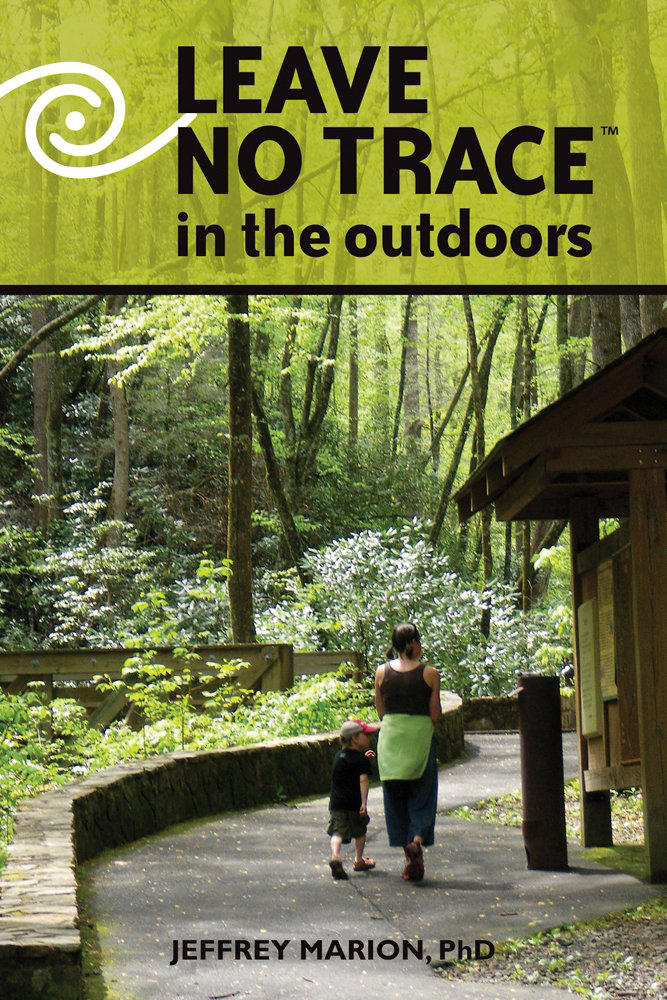New 'Leave No Trace' book is a guide for reducing impacts, from backcountry to backyard

From preserving wilderness to cleaning up after your dog at the local park, a new book outlines the principles and low-impact practices of Leave No Trace, a decades-old education program that guides outdoor recreation nationwide.
“Leave No Trace is about making decisions to protect the world around you,” said the book’s author, Jeff Marion, an adjunct professor in Virginia Tech’s College of Natural Resources and Environment and a recreation ecologist with the U.S. Geological Survey.
“The challenge is that different recreational activities and different environments require different practices,” said Marion, who was a founding member of the Leave No Trace Center for Outdoor Ethics and helped develop the Leave No Trace principles.
The book, “Leave No Trace in the Outdoors,” is a resource for federal and state land management agencies, recreation and conservation organizations, communities, and the general public. Proceeds go to the Leave No Trace Center for Outdoor Ethics.
Marion organized the book around the Leave No Trace Seven Principles:
- Plan ahead and prepare.
- Travel and camp on durable surfaces.
- Dispose of waste properly.
- Leave what you find.
- Minimize campfire impacts.
- Respect wildlife.
- Be considerate of other visitors.
The principles can be applied anywhere, from wilderness to local parks and backyards. The guide includes a chapter on each principle and explains how to apply the principles in different environments. Planning is a key part of each principle.
“Whether hiking a woodland trail, bird watching in a local park, or canoeing a whitewater river, every outdoor visit is enhanced when we take time to improve our outdoor knowledge and skills, and learn about the area we will visit,” Marion wrote in the chapter Plan Ahead and Prepare.
Carefully read all applicable rules when visiting public lands, he advises. Anticipate problems and prepare for them, such as changes in the weather or a twisted ankle.
While equipment needs vary with the activity and environment, the guide provides a list of 10 essentials for every trip, recommends low-impact gear, and provides food storage options.
In the chapter Travel and Camp on Durable Surfaces, Marion explains the types of surfaces to look for when there are no developed trails and how to disperse activity in pristine areas so visible impacts never form.
“Pack-it-in, pack-it-out” is the foundation of the chapter Dispose of Waste Properly. “Accept responsibility to keep the areas you visit litter free and prevent wildlife from obtaining your food or trash,” Marion wrote. “Carry plastic bags to collect trash and leftover food, and consider performing a community service by picking up and carrying out trash left by others.” Find out if pet and human waste can be buried; otherwise, pack it all out.
“Pass the gift of discovery on to those who follow,” wrote Marion in the chapter Leave What You Find. Picking flowers prevents seed formation and reproduction.
“Accept nature on its own terms,” said Marion. Avoid leaving your mark in the form of litter, damage to trees, campfire sites, or graffiti. Enjoy but do not alter historic, archaeological, and fossil sites. “They tell the story of our past,” he added.
Also, be careful that you do not add anything to an environment, such as seeds from invasive plants or non-native insects transported in campfire wood.
“Ecological studies have found that introduced earthworms, including bait worms released by anglers, have altered the soil and nutrient conditions of entire forests, increasing erosion and causing reduced forest organic litter, plant ground cover, and number and diversity of native insects,” Marion reports.
Consider not having a fire, Marion wrote in the chapter Minimize Campfire Impacts. Because of past damage, nearly half of National Park Service backcountry managers prohibit campfires. Marion would like to see responsible behavior reduce regulations and the cost of enforcement.
Build a campfire only when it is legal, when there is an existing fire site and an adequate supply of wood, and when the campfire can be safely managed and extinguished.
In the chapter Respect Wildlife, Marion wrote, “Wildlife face threats from loss and fragmentation of habitat, invasive species, pollution, overexploitation, poaching, and disease. Protected lands offer a last refuge from some, but not all of these problems.” Visitors should promote wild animals’ survival rather than add to the difficulties they already face, he said.
Human food turns small animals like chipmunks into aggressive beggars and exposes humans to disease such as rabies and hantavirus pulmonary syndrome. Bears have been known to break window glass and tear open trunk lids to get at food stored inside vehicles.
And wild animals will eat things that are not food but smell like food. “At Grand Canyon National Park, managers had to kill 22 food-attracted deer that became aggressive and dangerous,” Marion said. “Autopsies revealed underweight and malnourished animals with up to five pounds of plastic and foil food packaging obstructing their intestines.”
“Act in ways that reduce the potential for crowding, conflicts, and unnecessary noise,” Marion wrote in the chapter Be Considerate of Other Visitors. “The subject of outdoor etiquette is often neglected,” he said.
Respect for others is based on a series of presumptions. For example, “Presume that those you meet prefer to see and hear few other visitors,” he wrote.
“Choose to maintain a cooperative spirit,” Marion said. “Although our motivations and sense of adventure vary, there’s always room on the trail for people with open minds and generous hearts.”
Marion concludes that ethics are a crucial part of the Leave No Trace philosophy. “We can enjoy protected areas without harming them — but only if we assume a personal responsibility to learn about and apply the best available low-impact practices.”




